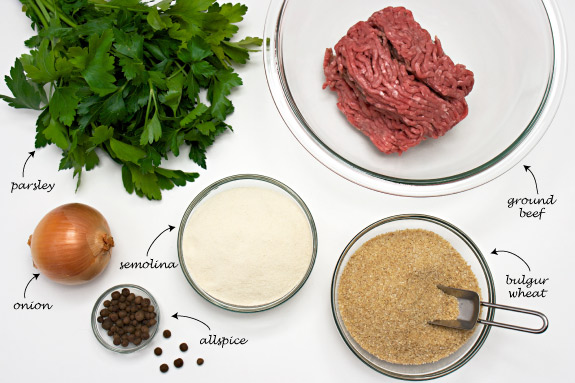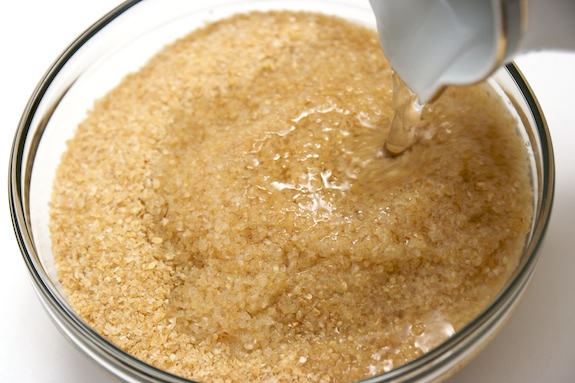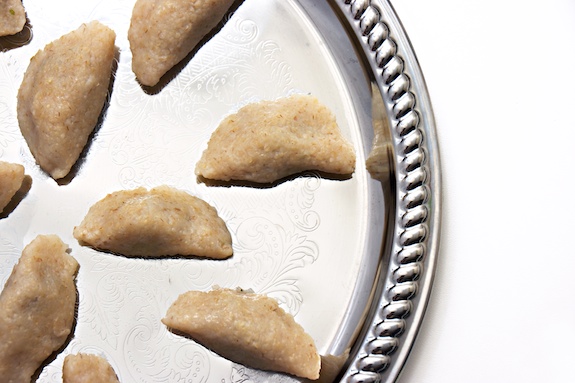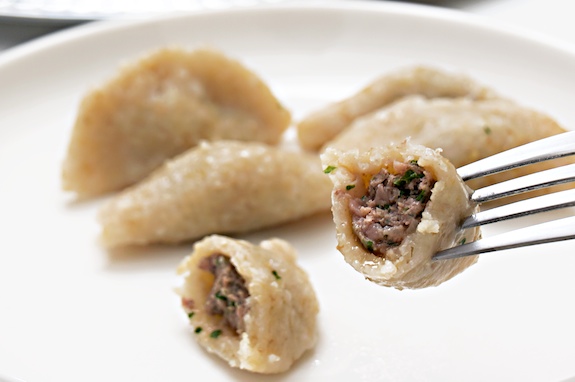Two weeks ago my immune system decided, all on its own (bless its heart), to wage war against pollen. Me against a militia of relentless yellow, practically invisible, warriors on a mission to spread and procreate. It was like a cheesy action movie. The kind where the one good guy goes up against hundreds of bad guys and kicks all their butts, blindfolded and with one hand tied behind his back; except my butt was handed to me. I was a miserable mess — puffy eyes, congested, endless sneezing, light headed, the works.
While I was out with allergies, this post took a back seat. It shouldn’t have, because this dish is pretty fantastic, healthy and delicious. It’s a post dedicated to Middle Eastern dumplings called Kbeibat (pronounced: k’beh-baat — كبيبات). This was the first time I made them without my grandmother, but she was there the entire time, over the phone, walking me through every step.

The dough for the dumplings is fairly basic: bulgur wheat, semolina and water. My first attempt at making the dough, however, was a complete disaster. Not only did my camera run out of batteries mid-shoot, but the dough was a nightmare as far as doughs go: a big sticky mess. According to my grandmother, I over-soaked the bulgur and added more water when I clearly didn’t need to. What was I thinking? I blame the allergies.

As long as you don’t over-soak your bulger, you’ll be fine. You want the water to cover the bulger wheat by about an inch. After about 15-20 minutes, discard any remaining water from the bulgur and mix with the semolina flour to make the dough. Usually, there will be little, if no water left to drain. My mistake was I kept adding more and more water, which is what ended up saturating the bulgur wheat in the first place.

If you remember when I blogged about kefta kabobs, the filling for these dumplings is the same: ground beef, onions, parsley, ground allspice and salt. Since we’re not adding any extra fat and we’re boiling these dumplings, you’ll want to make sure to buy a fairly fatty selection of ground beef. 85% works great for this dish.

Things to do while forming dumplings: watch a movie, listen to a podcast/audiobook, or invite friends who enjoy cooking and have them help. It makes the entire process go by a lot quicker.

Tip: Use ice-cold water to help keep the dough from sticking to your hands.

Dumplings cook in 4-6 minutes. Enjoy!

Kbeibat
yields approx 36 dumplings
Components
- 1 cup bulgur wheat, #1 grind (fine)
- 1 cup fine semolina flour
- water, for dough
- 1 lb ground beef, 85%
- 2 medium onions
- 1 cup flat leaf parsley, finely chopped
- 2 tsp allspice, ground
- salt, to taste
Putting them all together
- Quickly rinse and strain bulgur wheat using cold water. It’s ok if some water remains.
- Soak the bulgur wheat in cold water to cover the surface by a finger or two, no more.
- Let bulgur wheat sit for at least 15-20 minutes.
- In the meantime, prepare the meat mixture by mixing together the grated onion, parsley, allspice and salt* with the ground beef.
- Mix the bulgur wheat, semolina, and a little salt (1/2 tsp kosher salt) to form the dough. Knead until it comes together. If wet, add a little more semolina. If dry, add a little more water.
- Cover dough until ready to use.
- Fill a bowl with ice water to keep your hands wet while shaping the dumplings*.
- Roll a 1-inch wide ball of dough between your hands. Open a hole using your pointer in one hand, while rotating and holding the shape of the ball with your other hand. Once the hole is wide and the dough casing is thin, stuff it with a spoonful of meat mixture and seal by pressing the edge of the hole together. Alternatively, you can follow the easier disk method outlined in the diagram on the blog post.
- Arrange the dumplings on a large sheet pan lined with parchment paper (or lightly coated with oil) to prevent them from sticking.
- Bring a medium sized pot of water to a simmer and season with salt (as you would when you’re making pasta).
- Simmer the dumplings for 6-8 minutes in batches.
Notes: You can check the raw meat for seasoning by cooking a tiny piece on a skillet. It’s easier to work with and shape the dumplings when your hands are wet. It will help keep the dough from sticking to your fingers.

Be fried instead of boiled, similar recipe in Turkey called “İçli Köfte” look different than
Wowie what a post !!! I’m making these, and I’m so sure it’ll be such a hit at home …. thanks to you, now I have a new addition to my Lebanese recipes … !!!We have to get together n cook honey !!!!! BTW I hope you are feeling better, I’ve been under the weather too past whole week .. sigh … inshallah will be better soon. I’m really excited about making these.
Hi Anne! Thanks for the comment! I googled “İçli Köfte” — it reminds me a lot of كبة طرابلسية (literally translated kibbeh from Tripoli). These kibbeh are filled with cooked ground beef and are also fried like the Turkish İçli Köfte. It’s one of my favorite dishes 😀 I also found this Turkish food blog that steams the İçli Köfte, similar to the Kbeibat dumplings, and then pan fries them. My grandmother likes to do this with the left over Kbeibat for a slightly crisp exterior. The similarities make sense since Aleppo, Syria (where my family is from) is only about an hour from Turkey’s southern border. Thanks for sharing!
Thanks Kajal! I’m feeling a lot better now — thank you!! I agree, we have to get together at some point. I can picture it already: a huge feast with lots of Indian and Mediterranean flavors 😀 enjoy the dumplings!!
Oh man! Sorry to hear that. I hope you’re completely over it (I mean, with it being, er, Spring and all). I’ve never heard of these before but I’m naturally drawn to dumplings (Asian heritage, lol). They look really good!
This looks really good! Have you ever made the fried kind (sambousik)? I believe that the dough is made differently
Thanks Manggy! I am feeling a lot better now. Glad you liked the dumplings 🙂
Hi Dani! I have eaten sambousik, but have never made them at home. My grandmother is usually the one who makes them. You’re right, the dough is made differently — it’s a flour-based dough similar to the dough for empanadas (South American turnovers), if you’re familiar with those. I need to ask sito for her recipe and I’ll blog about it soon hopefully 😀
Your kbeibat look so good!
I’m not used to seeing bulgur in anything but grain form, this looks like a fun recipe to try a new ingredient in.
Isn’t it interesting that dumplings, in pretty much any cooking kingdom, are always tasty? Hurray for dumplings!
Marhaba Tony keefak?
I have never had these ; must be a Syrian specialty. Looks mighty good; any kind of kibbe is good in my book!
Salaam
That would be awesome! I love sambousik and empanadas! I’ll be looking forward to your blog about sambousik
Marhaba Tony
This is a real Assyrian Kebbeh, I did a posting about it last month too… INTA SYRIANEH?????
I am glad to see more people share and enjoy my food.
Tengo que hacer estas!
Solo espero que pueda encontrar los ingredientes en Okinawa, jaja.
I hope you’re feeling better!
Hi,
These are Assyrian dumplings we call “koutleh”.
They were first only known by the Assyrians in the Tur Abdin(Mountain of the servants God).That is right at the border with Syria. Kamishli is a town founded by Assyrians who fled in 1915 for the turks and koerds. Also a lot of refugees came to Allepo. And with them they brought their food. There is also a version of this from Diyarbakir. Then you put very finely ground meat through the dough.
Hello,
Nice blog! Just to finish what others said about the dumplings. These are indeed Assyrian dumplings,our delicious koutleh. And for a first time not bad. But before you can make them like the Assyrian grandmothers do,you’ll need a lot of practice. These are notouriosly difficult to make.Assyrian women make the dough very thin,before filling them.And the women who can make the koutleh like that,have a special place in the family and the community. And the women that can’t make them so good are always embarresed when asked about their koutleh-making skills. So important are these dumplings in our culture! Keep up the good work, and looking forward for more recipes.
I kind of know what you mean … my little guy (he’s just 3) suffered nearly 3 weeks with horrible allergies (tree pollen is his nemesis). And now both kids have been sick (or possibly affected by allergies) for six weeks on and off. It’s awful!!
Now, as for these little dumplings … they sound superb. Great recipe!
Wonderful post. I love the use of bulgur in a dumpling. Do you know the origins of these dumplings?
Well,the origin of this dumplings is Assyrian. Maybe you’re not aware of it,but there are still Assyrians in the Middle East.These dumplings only represent a small but important part of Assyrian cuisine and culture.Maybe a mayority are now arabs but for the arabs a different Middle-East existed for 5000 years.And the culture didn’t die, much of it was absorbed by the arabs who then added their own flavor to it. But the ancient people of the Middle-East may not be forgotten,because they are the founders of the Middle-Eastern food and culture.
Hi there. Just found your blog for the first time via Lottie+Doof on Twitter. 🙂 These dumplings look really good – I’ve never heard of making dough from bulgar wheat. Nice!
i love kibbe but never had them like this.. seems a lot healthier than the fried ones.. so gonna try these with my family this ramadhan
i have been reading all the comments on the kbabath i have been making them all my life we have a large community of mardennia in boston area i love the idea all the people that are involved in cooking ,that is my favorite thing to do .I am very happy to meet all of you.
can these be fried as well?
Zeki: Yes, the leftovers can be fried. Instead of heating them up in the microwave, families will dip leftover dumplings (which were originally boiled) in egg and pan fry them. This gives them a crispy crust that is absolutely delicious! I posted some photos of the fried kbeibat on my Facebook.
just saw your facebook pics of them..they look delicious..must try this!!
Shukran Tony…I just made these,I put the boiled dumplings in a lemony green vegetable broth( swiss chard,leeks,onion, garlic,zuccini, lemon ) delicious.. and saved a few to pan fry….love them after pan frying…after which I could tell my dough( shell) needed more seasoning. Have you fried them without the egg? and How are these usually served after just the boil in your family? thank you in advance
This origin from Kbeibat Is assyrian. Traditional in southern Turkey. Adn traditional in mi family from Mardin.
Dear all, I love these “ketal”. When made proper they are super delish and healthy. But I would like to point out that the dish is Syriac NOT Assyrian. Assyrian means “Ashoori”. and it is not an Ashoori dish, it is a Syriac or Syriani dish.
Peace to all
Confession, I love having this with some HP steak sauce ^_^
I don’t care where they are from, they are delish! My husband is from Syria and My grandparents were from Lebanon………….we call them Kibbebet, serve them when boiled with Laben (yogurt) made with garlic and mint. Let the left overs (if any) dry well and dip in beaten eggs then fry until they are golden brown and they will be great hot or at room temp with a salad and laben (yogurt). Saha